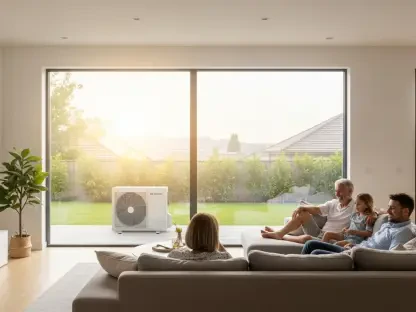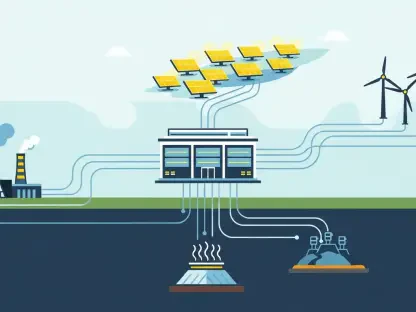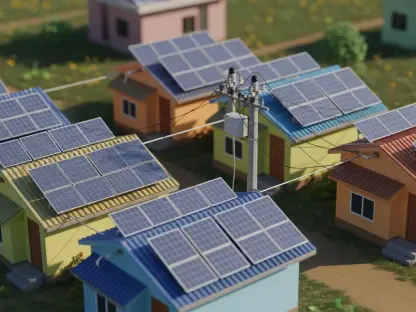Electric vehicles (EVs) are no longer just an eco-friendly transportation alternative. These vehicles are becoming an integral part of modern home energy solutions, playing a crucial role in reducing carbon dioxide emissions and optimizing energy usage. By integrating with various home energy systems like solar panels, batteries, and heat pumps, EVs are set to revolutionize how households consume and manage energy.
Electric Vehicles: Catalysts for Decarbonization
The Role of EVs in Reducing CO2 Emissions
Electric vehicles are pivotal in reducing personal transportation’s significant CO2 emissions. With traditional internal combustion engines contributing heavily to global carbon output, the shift to EVs marks a substantial step toward a greener planet. EVs offer more than just low-emission travel; they serve as a gateway to more sustainable living by seamlessly integrating with other home energy solutions. This capability extends the impact of electric vehicles beyond roadways, enabling them to function as dynamic elements within a home’s energy ecosystem.
Organizations and researchers emphasize that converting just a fraction of traditional cars to electric ones could result in drastic reductions in greenhouse gas emissions. When coupled with renewable energy sources such as solar or wind, the environmental benefits multiply. EVs can be programmed to charge during off-peak hours when energy demand is lower, which not only cuts costs but also reduces strain on power grids. As more households adopt these systems, we inch closer to meeting ambitious carbon reduction targets on a global scale. Additionally, the integration of EVs into smart home energy systems could foster more resilient, energy-efficient communities.
Beyond Transportation: Home Energy Integration
EVs are not merely limited to serving as transportation. These vehicles have the potential to interact with home energy systems in ways that maximize efficiency and minimize carbon footprints. They can be programmed to charge during off-peak hours when energy demand is lower and cheaper, thereby optimizing domestic power usage and reducing strain on the grid. As homes evolve to become smarter and more interconnected, the role of EVs as both a transportation mode and an energy fixture becomes increasingly significant.
Drawing power from home solar panels, EVs can store surplus energy produced during the day for use at night, effectively acting as a mobile battery. This setup extends the benefits of renewable energy by allowing households to store and use clean energy around the clock. The convergence of smart home technologies and electric vehicles holds the promise of creating self-sustaining systems where energy is efficiently managed and utilized. Furthermore, when home energy systems include components like batteries and heat pumps, the potential for optimized energy use expands. EVs, by interacting with these systems, can help lessen energy costs and carbon footprints significantly, carving a path toward more sustainable living environments.
E.ON’s TestingLab and Charger Validation
E.ON’s TestingLab in Essen plays a crucial role in validating domestic electric equipment, especially home EV chargers. The absence of standardized regulations has led to a variety of chargers with differing safety and reliability standards. Through rigorous validation processes, TestingLab ensures the safety and functionality of these chargers, contributing to a more reliable home energy ecosystem. Stringent testing protocols involve assessing multiple factors including efficiency, durability, and safety to ensure chargers meet the highest standards before hitting the market.
The meticulous work conducted by E.ON addresses the growing concerns consumers have around the reliability of their EV chargers. A validated, high-quality charger not only prolongs the lifespan of the vehicle’s battery but also ensures user safety during prolonged charging sessions. Partnerships with automobile manufacturers such as BMW, Volkswagen, and Harley Davidson further highlight the significance of these validation processes. E.ON provides comprehensive training to engineers, certifying installations, and ensuring that all products adhere to stringent quality controls. This collaboration aids in the development and dissemination of safe, reliable charging solutions, creating a foundation for a robust EV infrastructure within households across the region.
Challenges in EV Charger Design and Validation
The Complexity of Safe and Reliable Chargers
Delivering high power over extended periods while maintaining communication with a vehicle’s control circuits may appear straightforward, but many companies struggle with it. Issues like overheating and subpar engineering highlight the need for stringent validation processes. E.ON’s engineers receive comprehensive training to certify installations and test products for major automotive brands, ensuring quality and safety. These companies constantly battle challenges related to thermal management, reliability under different environmental conditions, and maintaining efficient electrical connectivity without compromising on safety.
These design challenges necessitate a holistic approach where engineering teams meticulously evaluate every component. It involves performing intensive tests such as thermal cycling, mechanical stress assessments, and long-term reliability trials to identify potential points of failure. Training programs by E.ON equip engineers with the know-how to detect and resolve such issues, thus setting a higher industry standard. By addressing these challenges head-on, E.ON is ensuring that the seamless, efficient transfer of power is accomplished without placing undue stress on electrical systems, thus preventing overheating and equipment damage.
The Proliferation of Charger Brands
The influx of numerous charger brands in the market leads to inconsistencies in safety and reliability. This situation necessitates thorough validation and certification processes to ensure that consumers have access to dependable charging solutions. The cooperation between E.ON and major car manufacturers addresses these concerns by setting higher standards for charger design and performance. Each brand’s charger must undergo rigorous testing protocols to be certified as safe and reliable for everyday use. With numerous chargers flooding the market, both consumers and industry stakeholders recognize the importance of trusted, validated products.
The absence of uniform standards has resulted in a fragmented market where the safety and performance of chargers can vary significantly. By adhering to strict validation processes, E.ON and its automotive partners work to mitigate these disparities, providing consumers with confidence that their chargers meet the highest quality benchmarks. This cooperative effort extends to information-sharing and joint development projects with manufacturers to innovate and refine charger designs continually. Such meticulous validation ensures that every approved charger contributes positively toward a cohesive, secure, and efficient EV charging ecosystem.
Innovative Public Charging Solutions
E.ON is also pioneering public DC chargers for trucks and other large vehicles. These chargers feature advanced designs like overhead gantries to avoid physical damage and built-in battery buffers to manage grid impact during peak demand times. Such innovations ensure the robustness of public charging infrastructure and mitigate the strain on public energy resources. Overhead gantries remove the risks associated with ground-level cables, offering a safer, more resilient solution for high-traffic areas. Additionally, battery buffers act as intermediaries, storing energy during low-demand periods to release during peaks, thus stabilizing the grid.
These public charging innovations mark a significant advancement in EV infrastructure, addressing the needs of larger commercial vehicles that require different charging solutions than passenger cars. The built-in battery buffers also make these chargers adaptable, capable of supplying consistent energy even when the grid experiences spikes in demand. E.ON’s approach not only improves the practical aspects of EV charging but also ensures that these energy solutions are future-proof and scalable. The company’s forward-thinking designs lay the groundwork for a sustainable, reliable, and efficient public charging network, highlighting the importance of innovation in supporting the transition to a greener transportation model.
Smart Charging and Grid Integration
Benefits of Smart Charging Tariffs
Smart charging tariffs allow EV owners to take advantage of lower electricity costs during off-peak hours. By automating the charging process, these tariffs help in reducing overall energy expenses and balancing the load on the grid. This system also encourages more efficient energy use and supports the integration of renewable energy sources. The primary advantage is economic, as charging during non-peak hours substantially lowers the cost for users, providing economic incentives for off-peak energy utilization.
Smart charging enhances the broader energy ecosystem by distributing demand more evenly throughout the day. This balancing act lightens the load on the grid during peak hours, which can prevent blackouts and reduce the necessity for grid expansions. Users set predetermined schedules, and the smart charging system kicks in to ensure that the vehicle is charged according to the most efficient and cost-effective plan. Therefore, the proliferation of smart charging represents a synergistic approach to energy management that benefits both the consumer and the energy infrastructure at large.
Persistent Network Connection Challenges
Ensuring that EV chargers maintain a persistent network connection is challenging. As households frequently change routers or internet service providers, maintaining this connectivity can be problematic. Without a stable connection, the benefits of smart charging cannot be fully realized, presenting a significant hurdle for EV integration in home energy systems. Network disruptions and reconnection issues impede the seamless operation of smart chargers, resulting in missed opportunities for optimized energy usage and cost savings.
A persistent connection ensures that real-time data on electricity prices and grid demands continuously inform the charging process. However, fluctuations in internet service undermine this capability, leading to inefficiencies. Maintaining a steady connection requires robust software capable of automatically reconnecting after disruptions and having fail-safe mechanisms that ensure ongoing operation. Addressing these connectivity issues is crucial to fully realizing the potential of smart charging systems. By overcoming these challenges, households will be better positioned to maximize the economic and environmental benefits of their integrated home energy systems.
Integrating EVs with Home Solar and Batteries
Combining EVs with home solar panels, storage batteries, and heat pumps provides an efficient and eco-friendly energy solution. This integration, while complex, offers the advantage of producing and storing energy locally, thereby reducing reliance on the grid and lowering energy costs. Optimizing the interaction between these systems is key to making the most of their combined potential. Homeowners can generate electricity during sunny periods, store excess energy in batteries, and use it to charge EVs or power home appliances, leading to significant savings.
The integration of these technologies requires advanced algorithms and smart energy management systems capable of making real-time decisions about when to generate, store, or consume electricity. Through such systems, homes can achieve a balanced energy profile, minimizing waste and maximizing efficiency. The synergy between EVs and other renewable energy technologies represents a step forward in achieving energy autonomy for households. This holistic approach not only benefits individual users but also contributes to a more stable and resilient overall energy grid by decentralizing and diversifying energy production and consumption at the local level.
Vehicle-to-Grid (V2G) Technology: A Future Game-Changer
The Concept of V2G Technology
Vehicle-to-Grid (V2G) technology allows EVs to return energy to the grid during peak demand, effectively using EV batteries as temporary energy storage. This system can help balance grid load, particularly when renewable energy sources are inconsistent. V2G represents a significant step forward in smart energy management, making the grid more resilient and efficient. By leveraging the storage capabilities of EV batteries, surplus energy can be drawn upon when needed, reducing the need for additional power plants and providing a more flexible energy landscape.
The concept of V2G shifts the role of EVs from merely being consumers of electricity to dynamic participants within the energy grid. This transformation offers several advantages, including better utilization of renewable energy and enhanced grid stability. As renewable sources like wind and solar can be intermittent, the ability to store and release energy as needed ensures a more consistent power supply. This dynamic energy interaction paves the way for a sustainable, balanced future where renewable energy can be maximized to its fullest potential.
Trials and Early Adopters
Early trials of V2G technology, such as those by E.ON in Cranfield and Octopus Energy’s Powerloop, demonstrate its potential. These initiatives aim to capture and redistribute energy stored in EV batteries, addressing the intermittency of renewable energy and offering a new layer of grid stability. The success of these trials indicates a promising future for widespread V2G adoption. Integrating V2G technology into public and private energy systems allows for a scalable solution to energy management and grid stabilization.
The pilot projects have shown encouraging results, highlighting the feasibility and benefits of deploying V2G at a larger scale. By proving that EVs can effectively feed energy back into the grid, these trials provide valuable data and insights for future implementations. They also offer a proof-of-concept that could pave the way for regulatory support and broader adoption. As these early trials mature, they set the stage for further innovations and refinements, ensuring that V2G becomes a cornerstone of smart energy management systems.
Challenges and Opportunities in V2G Implementation
While V2G technology offers immense potential, it also presents challenges such as regulatory hurdles, technological standardization, and consumer adoption. Overcoming these challenges requires coordinated efforts from policymakers, industry players, and consumers. Continued innovation and investment in V2G infrastructure will be crucial for realizing its full benefits. Regulatory frameworks must evolve to accommodate the bidirectional flow of energy, ensuring that policies support and incentivize V2G integrations.
Technological challenges include ensuring compatibility across different systems and optimizing the algorithms that control energy exchanges between the grid and EV batteries. Consumer education and acceptance are also paramount. Users need to understand the benefits and trust that their vehicle’s battery life will not be adversely affected. Clear, transparent communication from manufacturers and energy companies will help ease these concerns. Through collaborative efforts, the obstacles to V2G implementation can be surmounted, paving the way for a revolutionary change in how we manage and utilize energy on a global scale.









